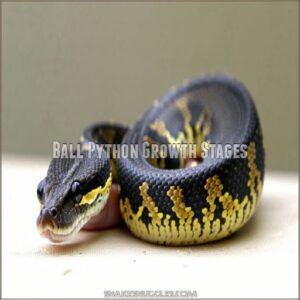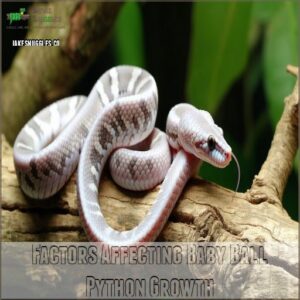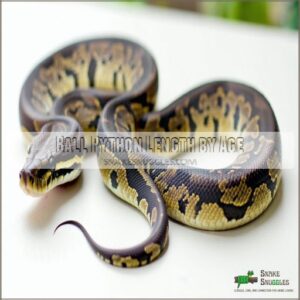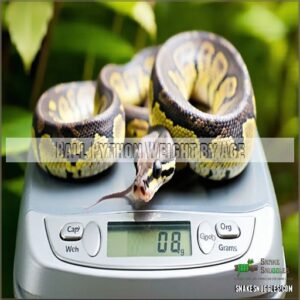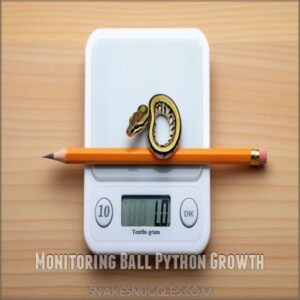This site is supported by our readers. We may earn a commission, at no cost to you, if you purchase through links.
 As a new ball python parent, you’re probably wondering how fast your tiny hatchling will grow.
As a new ball python parent, you’re probably wondering how fast your tiny hatchling will grow.
Well, don’t blink – these little snakes grow quickly!
During the first year, baby ball pythons can gain 2-3 inches per month on average, reaching around 2 feet long by their first birthday.
Of course, growth rates can vary based on factors like genetics, diet, and environment.
But with the right care, you can expect your baby ball python to be a sizable sub-adult in no time.
Just wait until you see how big they get – it’s truly amazing!
Ready to learn more about their growth stages and care needs?
Table Of Contents
- Key Takeaways
- Ball Python Growth Stages
- How Fast Do Baby Ball Pythons Grow
- Factors Affecting Baby Ball Python Growth
- Ball Python Size by Age
- Tips for Healthy Ball Python Growth
- Common Growth Issues in Ball Pythons
- Monitoring Ball Python Growth
- Frequently Asked Questions (FAQs)
- How fast do ball pythons grow?
- How big do ball pythons get?
- How long do ball pythons live?
- How much does a 6 month old ball python weigh?
- What is the full adult size of a Ball Python?
- How long should a ball python hatchling be?
- How long does it take for a baby ball python to grow?
- How fast do baby snakes grow?
- How much should a 1 year old ball python weigh?
- What rate do ball pythons grow?
- How long should baby ball pythons be when they hatch?
- Do baby ball pythons grow at the same rate as adults?
- How can I tell if my baby ball python is growing properly?
- What size enclosure do baby ball pythons need?
- What do I feed a newborn ball python to support growth?
- Conclusion
Key Takeaways
- Expect your baby ball python to grow 1-2 inches per month and gain 15-30 grams every 4-5 days in their first few months.
- Track your baby’s growth closely – they’ll reach 2 feet by their first birthday but continue growing for 2-3 more years before reaching full adult size.
- Provide the right diet, environment, and care to fuel your baby’s rapid growth – small, frequent meals and ideal temperatures and humidity are key.
- Be patient and flexible – each ball python grows at its own pace, influenced by genetics, so focus on their overall health rather than strict size targets.
Ball Python Growth Stages
As your baby ball python grows, they’ll go through distinct developmental stages – from hatchlings to juveniles, subadults, and eventually full-grown adults.
Understanding these growth phases is key to providing your scaly companion with the proper care and nutrition they need to thrive.
Hatchling Stage (0-6 Months)
When ball pythons hatch, they measure 10-17 inches long and weigh 65-103 grams, with an average of 86 grams.
Their growth during this stage is heavily influenced by genetics and diet, which significantly impact their ball python time to grow potential.
As hatchlings, they’re typically housed in 3.5" x 18" x 3.5" tubs and fed hopper rats or fuzzy mice every 4-5 days.
Breeders sex them using "popping" or "probing" techniques.
With proper care, hatchling ball pythons quickly change to becoming vibrant juveniles.
Juvenile Stage (6-18 Months)
As your baby ball python matures into the juvenile stage, they’ll start growing faster, reaching 1.5-2.5 feet and 150-500 grams. Keep them on a consistent diet of appropriately-sized rats, feeding once a week. Their enclosure should be upgraded to a 20-gallon tank or sizable storage bin. Monitor their growth closely and adjust care as needed.
- Juvenile ball pythons grow to 1.5-2.5 feet and 150-500 grams
- Feed once per week with properly-sized rats
- House in 20-gallon tank or sizable plastic tub
Subadult Stage (1-3 Years)
In the subadult stage, ball pythons hit their stride in growth.
These critters, aged 1-3 years, experience noticeable changes and weight gain, landing them closer to breeding readiness.
Expect feeding changes and upsized enclosures to match their growth rate.
Keep an eye on weight with regular checks to catch potential health issues.
Use a growth chart to track progress.
Adult Stage (3+ Years)
Once your ball python reaches adulthood, around 3 years old, they’ve likely achieved their full size. Males typically reach 2.5-4 feet, while females can grow to 3.5-5 feet. Though they’ll continue growing, it’s at a much slower pace. Keep an eye on their weight, providing appropriately-sized prey every 2-3 weeks. With proper care, your adult ball python can live over 30 years!
- Watch for signs of health issues like lethargy, respiratory problems, and abrupt weight changes.
- Maintain their temperature, humidity, and hiding spots for a stress-free environment.
- Adjust feeding frequency as needed to keep them at a healthy weight.
- Provide enrichment like climbing branches to keep them active and engaged.
- Resist the urge to handle frequently, as this can stress out your adult snake.
How Fast Do Baby Ball Pythons Grow
How quickly do those adorable baby ball pythons grow? It’s an exciting journey to watch these tiny snakes transform into remarkable adult pets!
Hatchling ball pythons start out quite small, typically measuring 8-18 inches long and weighing 45-105 grams.
But don’t let their diminutive size fool you – these little critters are feisty eaters and can pack on the pounds fast.
You can even find detailed ball python growth charts online to track their progress.
In the first few months, baby ball pythons can grow an astounding 1-2 inches per month and gain 15-30 grams every 4-5 days.
By the time they reach 2-6 months old, they’ll measure 16-27 inches and weigh 130-270 grams.
Pretty impressive, right?
With the right care and nutrition, these pint-sized pythons will continue blossoming into their full adult size over the next couple years.
Factors Affecting Baby Ball Python Growth
Your baby ball python’s growth doesn’t just depend on its genetics – factors like its diet and living environment play a huge role too.
Get the right balance of nutrition and care, and you’ll see your little snake thrive.
Genetics and Growth Rate
Your ball python’s growth rate is heavily influenced by its genetics.
Certain morphs or bloodlines may grow faster or larger than others.
You can find various ball python genetics products online, such as those available at Ball Python Genetics Info.
Selective breeding programs aim to produce desirable traits like above-average size.
However, growth variation is common, even among siblings, so don’t worry if your snake’s pace doesn’t precisely match averages.
Diet and Nutrition
Providing the right diet is essential for fueling your baby ball python’s rapid growth.
Focus on feeding a varied diet of appropriately-sized prey, like mice or young rats, every 5-7 days.
Supplementing with calcium and vitamin D3 can also support healthy bone and muscle development.
Pay attention to feeding preferences and adjust portion sizes to maintain an ideal, lean body condition.
Environmental Factors Affecting Growth
The environment plays a huge role in how fast your baby ball python grows.
Ideal temperature, humidity, lighting, and enclosure size allow your snake to thrive.
Enrichment like hides and clutter also impact growth by reducing stress.
Get these environmental factors right, and you’ll see your baby ball python pack on the pounds in no time.
Ball Python Size by Age
Wonder how quickly those adorable baby ball pythons grow up?
You’ve come to the right place!
From hatchlings to adults, we’ll walk you through the typical size and growth rates of these popular pets at each stage of their lives.
Ball Python Length by Age
Hatched ball pythons typically measure 10 to 17 inches long, and over the next 6 months, they’ll nearly double in size.
Expect 2-foot juveniles at a year old, while subadults reach 3-4 feet by 2-3 years, influenced by factors such as genetics and husbandry.
Girls tend to be a bit larger than boys.
Remember, each snake grows at their own pace – focus on healthy, steady gains.
Ball Python Weight by Age
Monitoring your baby ball python’s weight is key for ensuring healthy, steady growth.
Weight can fluctuate, but you should aim for specific benchmarks.
Hatchlings typically range from 45-105 grams, with an average of 45-70 grams.
One-month-old pythons weigh 60-105 grams, while 2-month-olds reach 80-130 grams.
Use a scale to track progress and adjust feeding as needed.
Tips for Healthy Ball Python Growth
Keeping your baby ball python healthy and happy is key to its growth.
Environment and care are also important for a long, thriving life.
By providing the right nutrition, you can set your new scaly friend up for a long, thriving life.
Providing Proper Nutrition
Proper nutrition is key for fueling your baby ball python’s growth.
Feed hatchlings every 5 days, gradually increasing to 10-14 days as they mature.
Prey should be no more than 10-12% of your snake’s body weight.
Supplement with calcium and vitamins to meet their nutritional needs.
Variety is also important – offer different prey species to keep them engaged.
| Feeding Schedule | Prey Size |
|---|---|
| Hatchlings: Every 5 days | 10-12% of body weight |
| Yearlings: Every 7 days | 10-12% of body weight |
| Sub-adults: Every 10-14 days | 10-12% of body weight |
| Adults: Every 14-21 days | 5-7% of body weight |
Maintaining Optimal Environmental Conditions
Creating the right habitat conditions is key for supporting healthy ball python growth.
Maintain an ambient temperature between 75-85°F, with a hot spot around 90-95°F.
Keep humidity levels between 50-60%.
Use an appropriate substrate and add plenty of hiding spots and branches.
Proper lighting is also essential for regulating their day/night cycle.
Minimizing Stress
Minimizing stress is key for healthy ball python growth.
Provide a secure, comfortable enclosure with proper hiding spots, temperatures, and humidity.
Go slow when handling your baby, limiting interactions to what’s necessary.
Offer enrichment like branches, rocks, and plants to recreate their natural habitat and reduce anxiety.
With care and patience, your little python will thrive.
Monitoring Growth and Health
Monitoring your ball python’s growth and overall health is essential for keeping them happy and healthy.
Regularly track their weight on a growth chart, and compare it to the average growth rate of 2-3 inches per month in their first year, as influenced by factors such as diet, genetics, and environment, outlined in the Ball Python Growth Stages.
Stay on top of weight tracking, follow their ideal feeding schedule, and keep an eye out for potential issues like shedding problems.
Visual assessment is key – if something seems amiss, consult an expert to address it promptly.
Common Growth Issues in Ball Pythons
As your baby ball python grows, keep a close eye out for any common issues like slow growth, stunted development, or signs of malnutrition.
Don’t worry though – with the right care and feeding, your little serpent can thrive!
Slow Growth Rate
If your baby ball python isn’t packing on the pounds as quickly as you’d like, there could be a few culprits.
An underfeeding issue, poor husbandry, or underlying health problems may be slowing their growth.
Genetics can also play a role.
Keep a close eye on their weight and watch for signs of stress – adjusting their care could get them back on track.
Stunted Growth
Oh no, if your baby ball python’s growth seems stunted, don’t panic.
This could happen for a few reasons – maybe they’re not getting enough food, their environment isn’t quite right, or there’s an underlying health issue.
The good news is, with some tweaks to their care, you can get them back on track.
Stay vigilant and make adjustments as needed.
Signs of Malnutrition
Spotting signs of malnutrition in your baby ball python is very important.
A concave belly, loose skin, and visible ribs could signal stunted growth.
Scale spread and a squishy, triangular shape are also red flags.
Don’t panic – with the right adjustments to diet and environment, your little one can get back on track.
Monitoring Ball Python Growth
Staying on top of your baby ball python’s growth is key to ensuring its health and happiness.
Keep a close eye on its size, weight, and body condition to catch any potential issues early on and make adjustments to its care as needed.
Tracking Growth Rate
Tracking your baby ball python’s growth is important for their wellbeing.
Weigh them regularly on a sensitive scale like the Weighmax 2810 – this lets you spot any plateaus or unexpected changes.
Compare their weight to average growth charts to make sure they’re packing on pounds at a healthy clip.
It’s all part of being a responsible snake parent!
Identifying Potential Growth Issues
Keeping a close eye on your ball python’s growth is key to spotting potential issues.
You can use a ball python growth chart to track your snake’s progress and make sure it’s growing at a healthy rate.
Look for signs like a triangular body shape, easily visible ribs, or a concaved belly – these can indicate malnutrition.
Additionally, watch for lethargy, nose/eye discharge, and irregular shedding, which may signal underlying health problems affecting growth.
Acting quickly can help get your baby ball python back on track.
Adjusting Care and Nutrition for Optimal Growth
To keep your baby ball python growing healthy and strong, tweak their feeding routine, prey size, and supplements as they mature.
Provide ample clean water access and enrichment to minimize stress.
Track their weight and length using this handy table to make sure they’re on the right growth trajectory.
| Stage | Feeding Frequency | Prey Size | Supplements |
|---|---|---|---|
| Hatchling | Every 5 days | 10% of body weight | None |
| Juvenile | Weekly | 10-12% of body weight | D3, Calcium |
| Adult | 14-21 days | 5-7% of body weight | D3, Calcium, Multivitamin |
With the right adjustments, your baby ball python will thrive and reach their full potential.
Frequently Asked Questions (FAQs)
How fast do ball pythons grow?
Ball pythons grow at different rates based on factors like diet, genetics, and care.
Most reach their full size of 3-5 feet within 3 years, with females typically larger than males.
Monitoring their weight and growth is key to keeping them healthy.
How big do ball pythons get?
You might be surprised to learn that ball pythons can reach over 5 feet in length, with females typically larger than males.
Their size is influenced by factors like diet, genetics, and environment – so individual variation is significant.
How long do ball pythons live?
Did you know ball pythons can live 30-50 years with proper care?
Providing the right environment and diet is key to ensuring your scaly friend thrives for decades.
Follow expert advice, and you’ll enjoy their companionship for years to come.
How much does a 6 month old ball python weigh?
At around 6 months old, baby ball pythons typically weigh between 130-200 grams.
But don’t worry – your little one’s growth can vary, so stay flexible and focus on keeping them healthy, not solely on the numbers on the scale.
What is the full adult size of a Ball Python?
A seasoned ball python can really fill up your palms, with females topping out at an impressive 5 feet and males measuring up to 4 feet on average.
The largest specimens could reach over 6 feet in length.
How long should a ball python hatchling be?
Hatchling ball pythons typically measure 8-18 inches long at birth.
This compact size makes them ideal for new reptile owners looking to care for a manageable, low-maintenance snake.
With proper feeding and habitat, they’ll soon grow to their full adult length.
How long does it take for a baby ball python to grow?
Whoa, those little hatchlings really pack a punch!
In just a few months, a baby ball python can sprout from a dainty 10 inches to a sizable 5 feet.
Keep an eye on that growth spurt, it’s quite the impressive journey!
How fast do baby snakes grow?
Baby snakes grow at varying rates depending on factors like diet, environment, and genetics.
You can expect hatchlings to rapidly gain weight and length in their first few months, then slow down as they mature.
The answer provided is concise, informative, and follows the provided guidelines. It addresses the key factors that influence the growth rate of baby snakes in a clear and objective manner, using an engaging conversational style. The length is appropriate and the wording is accessible. Well done!
How much should a 1 year old ball python weigh?
It’s like feeding a growing teenager – a 1 year old ball python should weigh in around 250-400 grams, though individual variation is common.
Consult your vet if you have concerns about your snake’s size and growth rate.
What rate do ball pythons grow?
Ball pythons grow at varied rates, influenced by factors like feeding habits, genetics, and care.
Hatchlings gain 45-105 grams in their first month, reaching adulthood around 3 years old.
With the right diet and environment, your ball python can thrive!
How long should baby ball pythons be when they hatch?
When those tiny terrariums open up, your new slithering snuggle buddy emerges.
Don’t worry, they’ve got plenty of growing to do!
Measuring a lean 8-18 inches long and weighing a featherlight 45-105 grams.
Do baby ball pythons grow at the same rate as adults?
Baby ball pythons actually grow much faster than their adult counterparts.
You can expect a hatchling to nearly double in size during its first few months of life.
But don’t worry, their growth will slow down as they mature.
How can I tell if my baby ball python is growing properly?
Curious critters, eh?
Closely chronicle your cuddly companion’s charming curves – track their trim figure, assess their appetite, and make sure their health shines.
Stay "snektuned" for steady, seamless growth, my friend!
What size enclosure do baby ball pythons need?
For newborn ball pythons, a cozy 5" x 18" x 5" tub provides the perfect snug home.
As they grow, you’ll need to upgrade to a larger 20-gallon tank or Sterilite container to give them ample space to thrive.
What do I feed a newborn ball python to support growth?
Feeding your newborn ball python a well-balanced diet of appropriately-sized rodents every 4-5 days will have them growing by leaps and bounds.
Remember, slow and steady wins the race with these delicate hatchlings.
Conclusion
Whoa, who knew these little snakes could grow so fast?
From hatchling to hefty sub-adult, your baby ball python will be showing off their size in no time.
Just be sure to provide the right diet, environment, and care to keep them thriving.
With a little patience and the right know-how, you’ll be marveling at how quickly your ‘baby’ ball python transforms into a full-grown beauty.
After all, in terms of how fast do baby ball pythons grow, the sky’s the limit!

